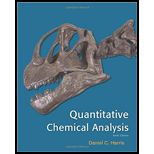
(a)
Interpretation:
Consider the titration given in the figure, balanced titration reaction has to be written.
Concept introduction:
- There is a law for conversion of mass in a
chemical reaction i.e., the mass of total amount of the product should be equal to the total mass of the reactants. - The concept of writing a balanced chemical reaction is depends on conversion of reactants into products.
- First write the reaction from the given information.
- Then count the number of atoms of each element in reactants as well as products.
- Finally obtained values could place it as coefficients of reactants as well as products.
(a)
Answer to Problem 16.1P
The balanced titration reaction is,
Explanation of Solution
Figure 1 shows the titration of iron (II) with cerium (IV).
(b)
Interpretation:
Consider the titration given in figure, two different half-reaction for the indicator electrode has to be written.
Concept introduction:
Half reaction:
The reaction component in which either the
(b)
Answer to Problem 16.1P
The half-reaction for this indicator is,
Explanation of Solution
In the Pt indicator electrode, there are two reactions come to the equilibrium,
Ferrous reduced to ferric and cerium reduced to ceric.
(c)
Interpretation:
Consider the titration given in the figure, two different Nernst equation for cell voltage has to be written.
Concept introduction:
Nernst equation is,
Where,
(c)
Answer to Problem 16.1P
Explanation of Solution
Nernst equation for the cell voltage
The two indicator reactions are,
We should write Nernst equation for these reactions.
So,
Formal potential for reduction of
Potential o saturated calomel electrode is
(d)
Interpretation:
Consider the titration given in figure, value of E has to be calculated for given volume.
Concept introduction:
Electrode potential (E): The electromotive force between two electrodes called electrode potential. Cell consists of two electrode, one is standard electrode (such as calomel electrode and standard hydrogen electrode) and another one is given electrode.
Where,
(d)
Answer to Problem 16.1P
Explanation of Solution
Titration:
As each part of
The equivalence point comes at
Before the equivalence point,
At
This is the method to equivalence point. So,
At
At
At
This is equivalence point
Adding these two voltage,
The cell voltage is,
At
After the equivalence point, the formula is used to calculate voltage of the cell is,
At
At
Want to see more full solutions like this?
Chapter 16 Solutions
Quantitative Chemical Analysis 9e & Sapling E-Book and Homework for Quantitative Chemical Analysis (Six Month Access) 9e
 ChemistryChemistryISBN:9781305957404Author:Steven S. Zumdahl, Susan A. Zumdahl, Donald J. DeCostePublisher:Cengage Learning
ChemistryChemistryISBN:9781305957404Author:Steven S. Zumdahl, Susan A. Zumdahl, Donald J. DeCostePublisher:Cengage Learning ChemistryChemistryISBN:9781259911156Author:Raymond Chang Dr., Jason Overby ProfessorPublisher:McGraw-Hill Education
ChemistryChemistryISBN:9781259911156Author:Raymond Chang Dr., Jason Overby ProfessorPublisher:McGraw-Hill Education Principles of Instrumental AnalysisChemistryISBN:9781305577213Author:Douglas A. Skoog, F. James Holler, Stanley R. CrouchPublisher:Cengage Learning
Principles of Instrumental AnalysisChemistryISBN:9781305577213Author:Douglas A. Skoog, F. James Holler, Stanley R. CrouchPublisher:Cengage Learning Organic ChemistryChemistryISBN:9780078021558Author:Janice Gorzynski Smith Dr.Publisher:McGraw-Hill Education
Organic ChemistryChemistryISBN:9780078021558Author:Janice Gorzynski Smith Dr.Publisher:McGraw-Hill Education Chemistry: Principles and ReactionsChemistryISBN:9781305079373Author:William L. Masterton, Cecile N. HurleyPublisher:Cengage Learning
Chemistry: Principles and ReactionsChemistryISBN:9781305079373Author:William L. Masterton, Cecile N. HurleyPublisher:Cengage Learning Elementary Principles of Chemical Processes, Bind...ChemistryISBN:9781118431221Author:Richard M. Felder, Ronald W. Rousseau, Lisa G. BullardPublisher:WILEY
Elementary Principles of Chemical Processes, Bind...ChemistryISBN:9781118431221Author:Richard M. Felder, Ronald W. Rousseau, Lisa G. BullardPublisher:WILEY





